Shopping Cart
- Remove All
 Your shopping cart is currently empty
Your shopping cart is currently empty

Glipizide (CP 28720) is a short-acting, second-generation sulfonylurea with hypoglycemic activity.

| Pack Size | Price | Availability | Quantity |
|---|---|---|---|
| 500 mg | 38 € | In Stock | |
| 1 g | 53 € | In Stock |
| Description | Glipizide (CP 28720) is a short-acting, second-generation sulfonylurea with hypoglycemic activity. |
| Targets&IC50 | KATP:6.4 nM ATP-sensitive potassium (IC50) |
| Kinase Assay | The activity of caspase-3, -8 and -9 is assessed using the caspase-3, -8 and -9 colorimetric assay kits, respectively. In brief, 1×106?cells in a 60-mm culture dish are incubated with 10 mM Valproic acid for 24 h. The cells are then washed in PBS and suspended in 5 volumes of lysis buffer provided with the kit. Protein concentrations are determined using the Bradford method. Supernatants containing 50 μg total protein are used to determine caspase-3, -8 and -9 activities. The supernatants are added to each well in 96-well microtiter plates with DEVD-pNA, IETD-pNA or LEHD-pNA as caspase-3, -8 and -9 substrates and the plates are incubated at 37°C for 1 h. The optical density of each well is measured at 405 nm using a microplate reader. The activity of caspase-3, -8 and -9 is expressed in arbitrary absorbance units. |
| Alias | K 4024, CP 28720 |
| Molecular Weight | 445.54 |
| Formula | C21H27N5O4S |
| Cas No. | 29094-61-9 |
| Smiles | S(NC(NC1CCCCC1)=O)(=O)(=O)C2=CC=C(CCNC(=O)C=3C=NC(C)=CN3)C=C2 |
| Relative Density. | 1.34 g/cm3 (Predicted) |
| Storage | Powder: -20°C for 3 years | In solvent: -80°C for 1 year | Shipping with blue ice. | |||||||||||||||||||||||||||||||||||
| Solubility Information | DMSO: 82 mg/mL (184.05 mM), Sonication is recommended. Ethanol: < 1 mg/mL (insoluble or slightly soluble) | |||||||||||||||||||||||||||||||||||
Solution Preparation Table | ||||||||||||||||||||||||||||||||||||
DMSO
| ||||||||||||||||||||||||||||||||||||

Copyright © 2015-2025 TargetMol Chemicals Inc. All Rights Reserved.